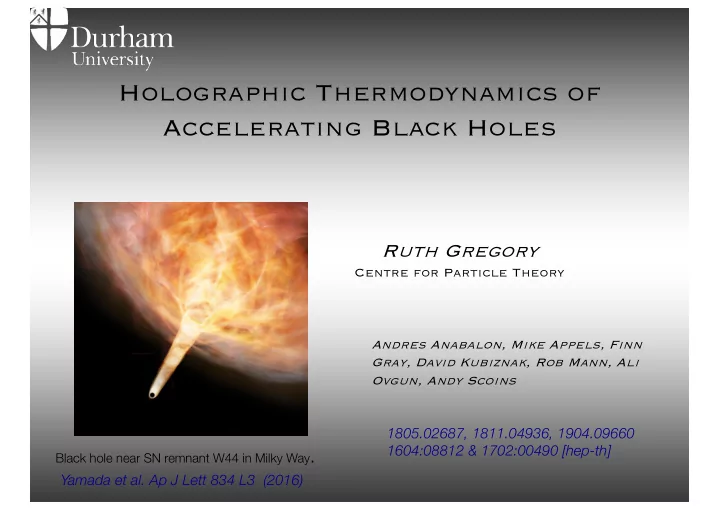

Holographic Thermodynamics of Accelerating Black Holes Ruth Gregory Centre for Particle Theory Andres Anabalon, Mike Appels, Finn Gray, David Kubiznak, Rob Mann, Ali Ovgun, Andy Scoins 1805.02687, 1811.04936, 1904.09660 1604:08812 & 1702:00490 [hep-th] Black hole near SN remnant W44 in Milky Way . Yamada et al. Ap J Lett 834 L3 (2016)
Outline o Accelerating black holes o Thermodynamics of tension o Acceleration and holography o Accelerating Chemistry
Accelerating a Black Hole? Black hole is the ultimate slippery object – to accelerate we must be able to push or pull on the actual event horizon. Anything touching the event horizon must fall in, unless travelling at the speed of light. Local energy-momentum must have energy=tension. Luckily – we have a candidate..
<latexit sha1_base64="sQTkHSloBtHqYTREGIDeBjilLU=">ACOnicbVBNa9tAFwl/UictHSYy5LTcGYOQkNCm9hPbSYwJxEvA65mn1ZC9ercTuU4gR+l29Ff01kMvPbSUXvsDunJMyEcHgwzb9h9E+VaOQrDb8HS8pOnz56vrDbW1l+83Ghubp25rLAS+zLTmb2IwKFWBvukSONFbhHSON5NP1Y+dXaJ3KzCnNchymMDYqURLIS6PmyemlSIuRMAUXkOc2u+YiRk1wWbZ3OxVvlyJKuK06XLzngvCayljBuOJCY0Jtn92pJ9wJubBqPKHOqNkKu+Ec/DHpLUiLXA8an4VcSaLFA1JDc4NemFOwxIsKamxaojCYQ5yCmMceGogRTcs56dX/I1XYp5k1o8hPlfvJkpInZulkd9MgSbuoVeL/MGBSWHw1KZvCA08uahpNCcMl73yGNlUZKeQLSKv9XLidgQZJvuzEv4V2Nt7cnPyZnu93eXnfvZL919GFRxwrbZq9Zm/XYATtin9gx6zPJPrPv7Cf7FXwJfgS/gz83q0vBIvOK3UPw9x+Am6wl</latexit> <latexit sha1_base64="h9RoEOPeLBdo5fqEcG5fKbTI1f0=">AB+3icbVDLSsNAFJ3UV62vWJduBovgqiRWtC6EogtdVrAPaEKZTCbt0MkzEzEvorblwo4tYfcefOEmDqPXAhcM593LvPV7MqFSW9WmUlpZXVtfK65WNza3tHXO32pVRIjDp4IhFou8hSRjlpKOoYqQfC4JCj5GeN7nK/N49EZJG/E5NY+KGaMRpQDFSWhqaVcnTCF4AZtOTOG1EyZDs2bVrRxwkdgFqYEC7aH54fgRTkLCFWZIyoFtxcpNkVAUMzKrOIkMcITNCIDTkKiXT/PYZPNSKD4NI6OIK5urPiRSFUk5DT3eGSI3lXy8T/MGiQqabkp5nCjC8XxRkDCoIpgFAX0qCFZsqgnCgupbIR4jgbDScVXyEM4znH6/vEi6x3W7UW/cntRal0UcZbAPDsARsMEZaIEb0AYdgMEDeATP4MWYGU/Gq/E2by0Zxcwe+AXj/QtwW5OL</latexit> Cosmic String ν ≈ δ (2) ( r ) diag ( µ, µ, 0 , 0) T µ A string produces a conical deficit, but no long range spacetime δ = 8 π Gµ curvature (no tidal forces).
The C-Metric ⇣ ⌘ An accelerating black hole is described by the C-metric ✓ d ✓ 2 " ◆# f ( r ) dt 2 − dr 2 g ( ✓ ) + g ( ✓ ) sin 2 ✓ d � 2 ds 2 = Ω � 2 f ( r ) − r 2 K 2 Where + r 2 1 − 2 m ⇣ ⌘� 1 − A 2 r 2 � f = ` 2 r g = 1 + 2 mA cos ✓ Ω = 1 + Ar cos ✓ Hong & Teo, CQG20 3629 (2003)
C-Metric Deconstructed ⇣ ⌘ Black hole: parameter “m”, cosmological constant, “ l ” ✓ d ✓ 2 " ◆# f ( r ) dt 2 − dr 2 g ( ✓ ) + g ( ✓ ) sin 2 ✓ d � 2 ds 2 = Ω � 2 f ( r ) − r 2 K 2 + r 2 1 − 2 m ⇣ ⌘� 1 − A 2 r 2 � f = ` 2 r g = 1 + 2 mA cos ✓ f determines horizon structure – black hole / acceleration / Ω = 1 + Ar cos ✓ cosmological constant
C-Metric Deconstructed Black hole: Set A=0, mass “m”, with (negative) cosmological constant, -3/ l 2 + r 2 dr 2 d ✓ 2 + sin 2 ✓ d � 2 ✓ ◆ ✓ ◆ 1 − 2 m ds 2 = dt 2 − � − r 2 r + r 2 ` 2 1 − 2 m K 2 r � ` 2 Gives familiar Schwarzschild – AdS K determines conical singularity on axis / axes
Conical Deficits Isolating the effect of K, look on axis through black hole: θ , φ ∝ d θ 2 + θ 2 ds 2 K 2 d φ 2 K relates to tension of “cosmic string” on axis ✓ ◆ 1 − 1 δ = 2 π = 8 π µ K c.f. Aryal, Ford, Vilenkin: PRD 34, 2263 (1986), Achucarro, Gregory, Kuijken: PRD 52 5729 (1995)
Deconstructing A ⇣ ⌘ Acceleration encoded in “A” ✓ d ✓ 2 " ◆# f ( r ) dt 2 − dr 2 g ( ✓ ) + g ( ✓ ) sin 2 ✓ d � 2 ds 2 = Ω � 2 f ( r ) − r 2 K 2 + r 2 1 − 2 m ⇣ ⌘� 1 − A 2 r 2 � f = ` 2 r g = 1 + 2 mA cos ✓ Acceleration shows up here as a Ω = 1 + Ar cos ✓ “shift” of infinity, and if m nonzero, a distortion of the spheres at a given “radius”
The Rindler Metric With no black hole, A appears to modify the AdS length scale, but the conformal factor means the boundary has shifted and is not at infinite r " ◆# f ( r ) dt 2 − dr 2 ✓ ds 2 = Ω − 2 d ✓ 2 + sin 2 ✓ d � 2 f ( r ) − r 2 Acceleration f = 1 − A 2 r 2 + r 2 ` 2 Ω = 1 + Ar cos ✓ Horizon
Recommend
More recommend